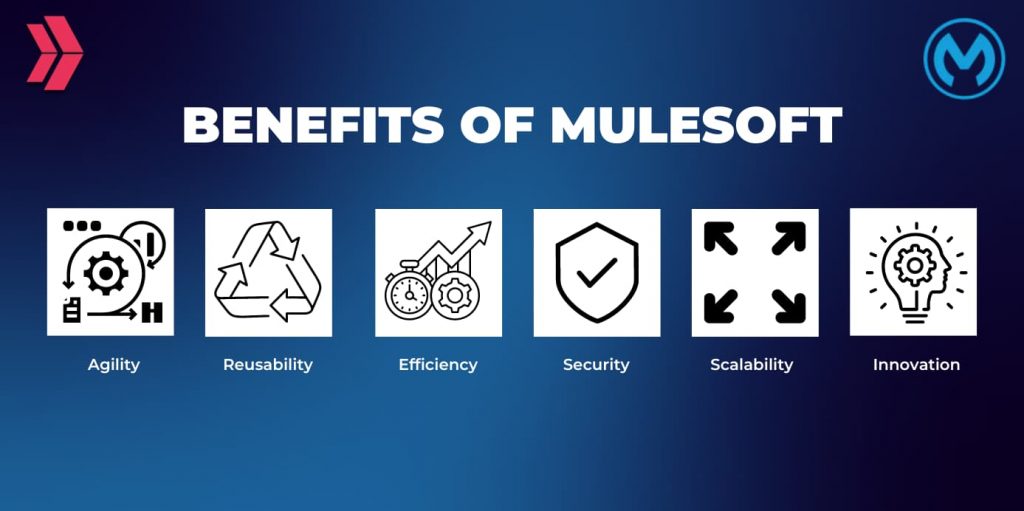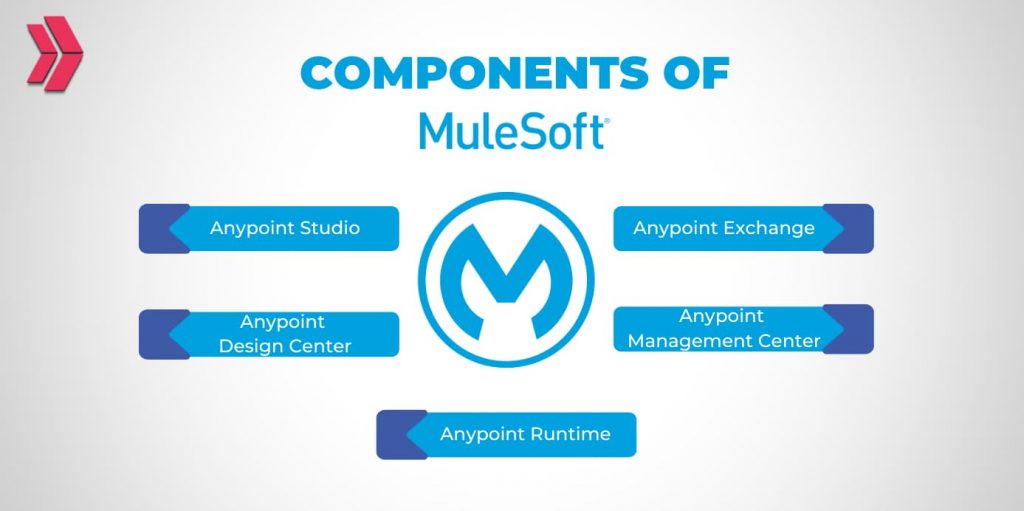In the rapidly evolving digital landscape, the ability to learn and understand complex technologies becomes crucial for businesses seeking to stay ahead. Salesforce, a leader in customer relationship management, has extended its capabilities with MuleSoft, an API-led connectivity solution. MuleSoft is a platform that allows businesses to connect any application, data, or device using application programming interfaces (APIs).
Mulesoft has 27% faster process automation, according to a 2022 study based on 3,706 interviews with customers in the United States, Canada, the United Kingdom, Germany, France, Australia, Singapore, Japan, and Brazil.
This comprehensive guide is designed to help you learn the intricacies of MuleSoft, understand its role in the Salesforce ecosystem, and prepare your business for the future with advanced API integration strategies. Through MuleSoft, Salesforce offers a bridge between disparate systems and data, opening a world of possibilities for seamless integration and streamlined operations. Whether you are new to Salesforce or looking to deepen your expertise in API integration, this guide will equip you with the knowledge needed to leverage MuleSoft effectively in your business environment.

What is MuleSoft?
Salesforce MuleSoft, acquired by Salesforce in 2018, is a platform enabling businesses to connect applications, data, and devices across various environments. It’s a part of Salesforce’s broader CRM solutions, enhancing the ability to deliver personalized experiences.
How Does MuleSoft Enhance Salesforce’s Capabilities?
By providing API-led connectivity, MuleSoft enhances Salesforce’s ability to integrate data and applications, thus driving efficiency and innovation in business processes.
What is MuleSoft Used For?
MuleSoft Salesforce offers extensive capabilities in:
- Integrating data from diverse sources.
- Exposing data and functionalities as APIs.
- Orchestrating business processes and workflows.
- Creating custom applications.
How Does MuleSoft Facilitate Integration and API Management?
MuleSoft simplifies the integration process, allowing businesses to connect various applications and data sources efficiently. It also enables the creation and management of APIs, enhancing data accessibility and system functionality.
What Are the Benefits of MuleSoft?
MuleSoft offers six main benefits:
- Agility
- Reusability
- Efficiency
- Security
- Scalability
- Innovation

Agility
MuleSoft enables businesses to respond faster to changing market demands and customer expectations by allowing them to create and modify APIs and integrations in minutes or hours instead of weeks or months.
Reusability
MuleSoft enables businesses to reuse existing assets and avoid duplication of effort by allowing them to create modular and composable components that can be easily shared and reused across different projects and teams.
Efficiency
MuleSoft enables businesses to reduce operational costs and complexity by using a single platform that can handle any integration scenario across any environment.
Security
MuleSoft enables businesses to protect their data and systems from unauthorized access and attacks by allowing them to apply consistent policies and governance to their APIs and integrations.
Scalability
MuleSoft enables businesses to handle increasing volumes of data and transactions by allowing them to scale their APIs and integrations horizontally or vertically without compromising performance or reliability.
Innovation
MuleSoft enables businesses to unlock new opportunities and value propositions by leveraging data and functionality from different systems and APIs.
What Are MuleSoft’s Main Components?
Here are the 5 key components of MuleSoft;
- Anypoint Studio
- Anypoint Design Center
- Anypoint Exchange
- Anypoint Management Center
- Anypoint Runtime

1. Anypoint Studio
Anypoint Studio is an integrated development environment (IDE) provided by MuleSoft. It serves as a versatile platform for designing, building, testing, and debugging APIs (Application Programming Interfaces) and integrations. Built on Eclipse, it accommodates Java, XML, Groovy, and other programming languages. Anypoint Studio aids in the creation of RESTful or SOAP APIs, orchestration of data flows, transformation of data formats, implementation of error handling, and other functionalities. The IDE also furnishes tools for automating testing, deployment, and documentation of APIs and integrations.
2. Anypoint Design Center
Anypoint Design Center is a web-based tool provided by MuleSoft that enables users to design APIs (Application Programming Interfaces) and integrations using a low-code or no-code approach Anypoint Design Center supports the creation of API specifications using RAML or OAS, the design of API portals with API Designer, the construction of integrations using Flow Designer, and the simulation or mocking of APIs through API Mocking Service. Collaboration with fellow developers and stakeholders is facilitated using Anypoint Exchange and Anypoint Visualizer within Anypoint Design Center.
3. Anypoint Exchange
Anypoint Exchange is a platform provided by MuleSoft that functions as a repository for reusable assets, expediting the development process. This platform facilitates the discovery, sharing, and consumption of APIs, connectors, templates, examples, documentation, best practices, and other integration assets. Additionally, Anypoint Exchange allows the publication of custom assets, making them accessible to the organization or the public. Its role extends to enhancing developer productivity and promoting asset reuse by establishing a centralized source of truth for integration assets.
4. Anypoint Management Center
Anypoint Management Center is a web-based tool provided by MuleSoft that serves as a centralized hub for managing and monitoring APIs and integrations. Within Anypoint Management Center, functionalities include deploying APIs and integrations across different environments through Anypoint Runtime Manager, ensuring API and data security via Anypoint Security, scaling APIs and integrations using Anypoint Runtime Fabric or CloudHub, analyzing API performance and usage with Anypoint Analytics, addressing API issues through Anypoint Monitoring or API Functional Monitoring, and governing the API lifecycle via API Manager.
5. Anypoint Runtime
Anypoint Runtime is the engine that powers your APIs and integrations. It is based on Mule, a lightweight Java-based enterprise service bus (ESB) that supports various protocols, transports, formats, standards, and technologies. Anypoint Runtime operates on-premises or in the cloud, with deployment options including CloudHub, Anypoint Runtime Fabric, Kubernetes, Docker, or standalone servers. This runtime solution ensures high availability, scalability, reliability, security, and performance for your APIs and integrations.
How Do These Components Work Together?
Each component serves a unique purpose, from development environments to management tools, working cohesively to provide a comprehensive integration solution.
What Role Does MuleSoft Play in the Salesforce Ecosystem?
MuleSoft’s role in the Salesforce ecosystem encompasses:
- Integrating Salesforce with other systems.
- Exposing Salesforce data as APIs.
- Developing custom applications on Salesforce.
How Does MuleSoft Improve Salesforce Integration?
MuleSoft extends the capabilities of Salesforce with the Anypoint Platform, enabling seamless integration with a variety of systems and applications and making custom application development easier. Anypoint Platform works to provide a comprehensive solution for enterprise integration. Understanding ‘what is Salesforce‘ is fundamental in appreciating how MuleSoft amplifies its capabilities, particularly in the areas of integration, API management, and application development within the expansive Salesforce ecosystem.
What Training and Certification Options Are Available for MuleSoft?
To master MuleSoft, several training and certification courses are available:
- MuleSoft Fundamentals
- MuleSoft Development
- MuleSoft Architecture
Why is MuleSoft Certification Important?
MuleSoft certification validates professional competence, offering a competitive edge in the job market and enhancing credibility in the field. Furthermore, obtaining a MuleSoft certification can complement Salesforce certification paths, enriching your overall qualifications and demonstrating a comprehensive skill set in both MuleSoft and Salesforce technologies.
What Resources Are Available for MuleSoft Training?
There are many resources available for MuleSoft training. Some of the resources are:
- MuleSoft’s official website
- Official training courses
- Certification guides
- Sample questions and mock tests
- MuleSoft community
How Can These Resources Benefit MuleSoft Learners?
These resources provide comprehensive knowledge, practical skills, and community support, essential for mastering MuleSoft. Additionally, integrating these resources with broader Salesforce training programs can further enhance the learning experience by providing a more holistic understanding of how MuleSoft fits within the Salesforce ecosystem.
What Are the Job Opportunities in MuleSoft?
MuleSoft is a fast-growing and high-demand technology that offers many job opportunities for professionals with MuleSoft skills and knowledge. Some of the MuleSoft job roles that require or prefer MuleSoft skills are:
- MuleSoft Developer
- MuleSoft Architect
- MuleSoft Administrator
What Do These Roles Entail?
Each role requires specific skills and knowledge in MuleSoft’s functionalities, contributing to the development, design, or administration of MuleSoft solutions.
Refer to the Salesforce roles and responsibilities guide for more detailed insights into how MuleSoft integrates with and enhances Salesforce functionalities.




